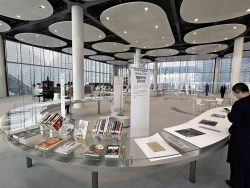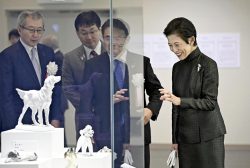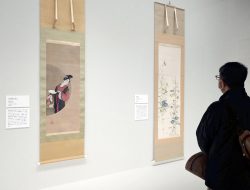18:32 JST, July 15, 2021
When I was young, I spent many Sunday nights rubbing my sleepy eyes and watching old Western movies alongside my father. Among the leitmotifs of the Wild West — saloons, gunfights, cattle drives, campfires — what stuck in my mind were the arrival scenes at the train stations. There’s nothing but a water tank, an excuse for a platform and the tracks that stretch as far as you can see. A distant whistle echoes across the desolate land. A little dot appears on the horizon and grows bigger and bigger into the shape of a train. Now you can hear the chugging of the steam engine, another whistle, much louder this time, and the screeching brakes.
As the train comes to a full stop, off comes the hero/heroine (think, for example, “Once Upon a Time in the West”) or a villain (“High Noon”). Whether hopeful, determined or apprehensive, their arrival unfailingly catapults the story forward as they bring with them attitudes and habits, grudges and romances, from the distant world.
Trains and the outsiders they bring signify change, sometimes forward-looking and beneficial, sometimes destructive and unwelcome. Yet the West cannot be won overnight. Those who disembark have to negotiate a long bumpy ride through the untamed land that quickly reveals gritty local entanglements (“The Big Country”).
When I arrived in early 21st-century California, I discovered that railroads had all but perished under the weight of the intervening century, during which cars and freeways became the favored mode of transportation. The only train line in my area is called Metrolink, which runs one train an hour for commuters from the nearby city of San Bernardino to downtown Los Angeles.
Grand, ornate stations at each end of the line (the San Bernardino Santa Fe Depot and Los Angeles Union Station) are the only reminder of the vital role railroads once played in this region.
I also discovered that taking the Metrolink to L.A. is nearly as complicated as traveling across the early 20th-century West. You have to leave home early to allow for unpredictable freeway traffic, fight for one of the scarce parking spots and run to the station.
The train is also painfully slow. It stops at a dozen stations along the way; sometimes, it stands still on the tracks for a long time with no explanation. Once you arrive in L.A., you need to find another ride to your destination, via bus, subway, cab, a shared ride or a combination of the above.
After all this, you must cut your evening short to catch the last train home, which departs at 7:30 pm. Back in San Bernardino, walking wearily across the deserted parking lot, you think to yourself you’ll just drive next time.
All this will change when the new Arrow train line connects the city of Redlands and the San Bernardino train depot. I’ve been hearing about this mythical passenger rail ever since I moved here and didn’t believe it would actually happen until construction began two years ago. It’s expected to begin service in less than a year, with Arrow proponents envisioning a more vibrant, diverse and prosperous Redlands in the future.
It will make Metrolink a much more viable transportation option, help reduce congestion on the freeway and city streets alike, and encourage economic development. The city is pushing to build high-density housing near the train station, ideal for those who would like to commute to Los Angeles by train. Even the university — at the end of the train line — is banking on modest commercial development on its campus.
However, others wonder if it will also bring — just like the railroad in the old West — unpredictable and undesirable change to their community. Situated in the inland region east of Los Angeles, Redlands is known as a gem of a city that has escaped suburban sprawl and retained its “small town feel” for decades. Now that Los Angeles and Orange counties are overcrowded and outrageously expensive, more and more people are moving east to this area in search of affordable housing and a better quality of life.
Many long-term residents worry that the train will facilitate this movement and bring more big-city problems, increase crime, overburden their excellent school district, and make the community less family-friendly.
They also fear that the influx of people from the big city will destroy the character of their community and turn it into yet another nondescript suburb of Los Angeles.
There is no doubt that the significance of the new train line will be multiple, ambiguous and even contradictory, and that its impact depends largely on the social and economic standing of each community member. High-density housing in the downtown area is a boon to those who need to commute long-distance and want to reduce car dependency; to residents with long family roots here, it’s the destruction of the city’s history and familiar way of life. Economic (re)development signals new opportunities for up-and-coming entrepreneurs and businesses that are looking to expand into the area; local business owners already here see increased competition and higher overhead.
When the train arrived in the old West, the resulting changes divided the fortunes of those who won and those who lost. We’ll soon find out the real-life effects of the new train line, as the story of how the East is won and lost unfolds along those newly laid tracks.

Sawa Kurotani
Kurotani is a professor of anthropology at the University of Redlands.
"Culture" POPULAR ARTICLE
-

Van Cleef & Arpels Dazzles with Art Deco Artisanry at Tokyo Exhibit
-

Disney’s ‘Twisted-Wonderland’ Animated Series Puts Villains in Spotlight: New Show Features School Inspired by Classic Disney Films
-

Japan Plans to Distribute Manga Overseas Via New Platform
-

Ayumi Hamasaki’s Shanghai Concert Canceled Day Before Schedule as Part of Beijing Backlash
-

‘The World Masterpiece Theater Series’ Celebrates 50 Years; Animator Looks Back on Creating Anime Classics
JN ACCESS RANKING
-

Keidanren Chairman Yoshinobu Tsutsui Visits Kashiwazaki-Kariwa Nuclear Power Plant; Inspects New Emergency Safety System
-

Imports of Rare Earths from China Facing Delays, May Be Caused by Deterioration of Japan-China Relations
-

Tokyo Economic Security Forum to Hold Inaugural Meeting Amid Tense Global Environment
-

University of Tokyo Professor Discusses Japanese Economic Security in Interview Ahead of Forum
-

Japan Pulls out of Vietnam Nuclear Project, Complicating Hanoi’s Power Plans


























